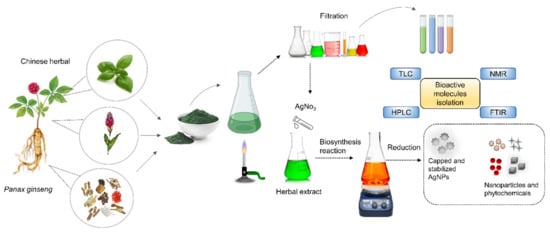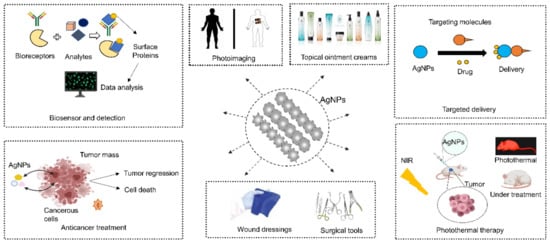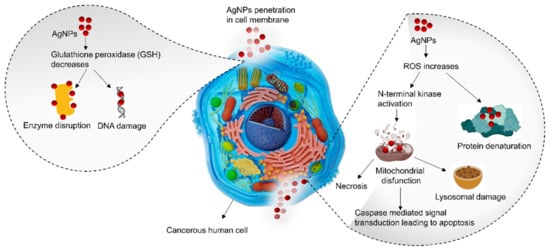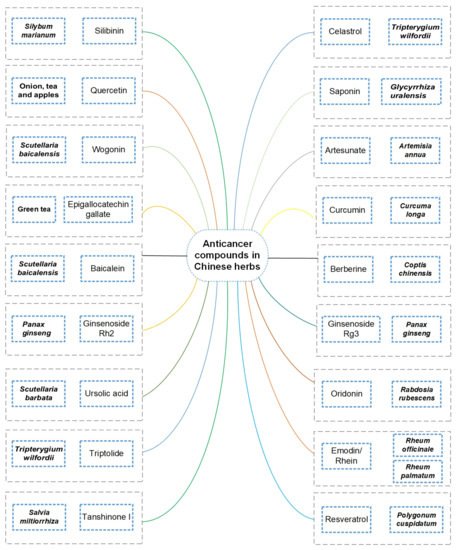1000/1000
Hot
Most Recent

Biologically synthesized silver nanoparticles (AgNPs) are potential antimicrobial agents commonly used in clinical treatment, such as wound dressing, topical ointments and anticancer agents. Recently, AgNPs with leaf and root extract ofPanax ginsenghave been successfully synthesized and showed potential antimicrobial activity. Different parts of Chinese herbs, including leaves, stenches, roots, and fruit extract, are widely applied for curing diseases.
Biological synthesis, often known as 'green synthesis', is a new trend in nanomaterial synthesis that offers the advantage of natural resource utilization and a simple, cost-effective, and environmentally friendly approach [1][2][3]. The biological pathway for AgNPs synthesis is dependent on macromolecular compounds found in bacteria, fungi, and algae and plant bioactive components. Plant-mediated AgNPs synthesis has gained popularity due to its strong reducing capability, fast synthesis, non-pathogenic action and antimicrobial activity [4]. Using Chinese herbs, AgNPs have been synthesized from Panax ginseng Meyer, Dendropanax mobifera Leveille, Angelica pubescens, Tamarix gallica, and Terminalia chebula [5], showing potential antimicrobial, anticancer, and antioxidant activity [6]. Modern scientific approaches suggested that AgNPs could be used as a potential antimicrobial agent against multi-drug-resistant strains with minimum human toxicity and extensive clinical applications [7][8].
Phytonanotechnology has emerged as a new approach in using Chinese herbal or medicinal plants for pharmaceutical applications. Each plant contains an orchestra of phytochemicals with higher therapeutic values and is free of harmful substances [9][10]. These chemically complex phytochemicals can reduce Ag + to Ag 0, such as peptides, enzymes, carbohydrates, and various organic compounds that serve best for medical applications. Silver has the potential to restrict bacterial growth by interfering with cellular molecules [11]. The biosynthesis of AgNPs using Saraca indica leaf extract is employed to characterize bactericidal efficacy against Escherichia coli ( E. coli ), Staphylococcus aureus ( S. aureus), and Micrococcus luteus [12], suggesting that medicinal plant-based AgNPs with a spherical shape and desired size of 23 nm have potent antibacterial activity. Similarly, the Withania coagulans herb was widely used as a folk remedy against diabetes, hypercholesteremia, and cancer. The leaf extract W. coagulans is used for AgNPs synthesis to assess its antibacterial, antioxidant, and cytotoxic properties [13]. Recently, the biological synthesis of AgNPs using Curcuma longa aqueous extract to exploit its antibacterial activity against E. coli and Listeria monocytogenes [14] showed the potential reducing ability of silver salts in comparison to other plants. However, further research is required to analyze the complicated molecular composition of Chinese herbal extracts and their interaction with AgNPs.
Chinese herbal root and leaf extract has been widely used to synthesize AgNPs and render unique antibacterial and antiviral activity. Traditional Chinese medicine (TCM) is being progressively used for clinical purposes in the treatment of different diseases [15][16]. Cinnamomum cassia , a Chinese herb, has been reported to be less toxic and exhibit potential antimicrobial activity. It could be formulated with other medically important herbs for multi-purpose use in medical fields [17]. Similarly, the root extract of Angelica pubescens Maxim. is widely used to synthesize AgNPs for in vitro antioxidant activity and control bacterial pathogenicity [18]. Moreover, the cytotoxic effect was further analyzed in murine macrophages (RAW264.7) as their anti-inflammatory potential [5]. It is evident from previous research that AgNPs and Chinese herbs are potential antimicrobial agents and have high prospects for clinical purposes. As a result, the combination or synergistic effects of Chinese herbs and AgNPs harnessed antibacterial and healing properties with minor adverse effects, making it the best candidate for biomedical applications. The progression of comprehensive research on Chinese herb-mediated AgNPs via phytonanotechnology has the potential to have enormous future implications.
For millennia, Chinese herbs have been utilized as a pharmaceutical and dietary supplement. Still, most researchers have focused on clinical therapy, despite its properties for nanomaterial synthesis and applications being prominent [19]. Chinese herbal medicine is thought to have been used for more than four thousand years, primarily during the Xia era. Shennong, the divine farmer, is considered to be the inventor of Chinese herbal medicine [20]. These Chinese herbs possess various potentially bioactive molecules such as flavonoids, quinones, lignans, tannins, terpenoids, and other endogenous metabolites that could be used as antioxidants [21]. Moreover, it has been demonstrated that bioactive molecules derived from Chinese herbal medicine have played, and are playing, an important role in curing diseases and boosting immunity [22]. These bioactive molecules exhibit remarkable reducing and stabilizing properties, indicating that they have significant therapeutic potential in preventing and treating various complex and heterogeneous diseases, such as cancer.
Chinese herbal practitioners have been recording their experiences for thousands of years. Chinese herbal medicine is one of the earliest medicinal remedies that have played an important role in curing many diseases. Most Chinese herbs, such as Cinnamomum cassia, Ephedra sinica, and Zingiber officinale, are commonly used as vital food supplements and folk medicines [23]. The fundamental theories of TCM were written in the 2nd century and are framed on Huang Di Nei Jing , which means ‘prevention before disease occurrence’ and contains many methodologies to control and prevent the spread of diseases and their recurrence after recovery [24]. Li Shizhen wrote a classical Chinese text on Chinese herbal medicine in the 16th century, recording 1892 distinct herbs and 11,096 medicines that control and prevent various diseases [25][26]. Nowadays, traditional herbal treatment for human diseases has been replaced by modern Western medicine and pharmaceuticals. However, Chinese herbal medicine is still widely used in China [27]. In the last 70 years, China has established the structure-based foundation of Chinese herbal medicine universities, hospitals, and research institutes to utilize the Chinese herbs for biomedical applications. Chinese herbal medicine is considered a natural reservoir of active compounds, and many researchers have investigated various phytochemicals, including proteins, amino acids, coumaric acid, aldopentose, calcium oxalate and polysaccharides. The composition of these bioactive molecules validates the synergistic effect against microbial pathogenicity [28][29].
According to the theory and principles of Chinese herbal medicine compatibility, component-based Chinese medicine is a new type of TCM formulated from herbal extract standard ingredients in fixed proportion [30]. Astragali radix are the dried roots of Astragalus membranaceus (Fisch.), one of the most common herbal drugs with potential antioxidant properties and antiviral activities. More than 100 compounds have been identified in Astragali radix, such as flavonoids, saponins, and polysaccharides, and their biological properties were highlighted [31].
Among biological methods, phytonanotechnological synthesis is considered as a novel approach. The phytochemical reduction method is comparatively slower than a conventional chemical reduction in earlier times. However, this limitation is resolved by using microwave-assisted synthetic techniques so that biological synthesis can be carried out rapidly with good yield [32]. Bioactive components or phytochemicals with various functional groups, such as hydroxyl, carbonyl, and amidogen groups, are ideal for adsorption on the metal surface to reduce Ag + to Ag 0. Chinese herbal extracts contain various bioactive molecules (carbohydrates, phenolic acids, flavonoids, aminoacids, and proteins). Therefore, they can exhibit multiple functionalities (reducing and stabilizing agents) and acquire different morphological structures with multifunctional organic molecular assemblies. In general, phytochemical-based AgNP synthesis involves three steps: (1) selection or use of herbal extract, (2) study nucleation and growth of AgNPs, and (3) selection of solvent media for extraction of phytochemicals [33], as shown in Figure 1 . Recent research has pointed out that, in addition to the quality of herbal extract or metabolites and their concentrations, various other parameters, such as temperature, reaction time, pH, the concentration of metal precursor, and electrochemical potential, can affect the reduction process [34][35]. Therefore, it is easy to obtain the desired size of AgNPs by changing the synthesis parameters.

China is abundant in plant resources, and the majority of its medications are derived from natural products. The development of modern drugs from natural products was mostly emphasized in the 19th century. Chinese herb-derived medicine has been primarily used as a therapeutic therapy for several decades since it had fewer side effects and complications [36]. Non-toxic Chinese herbs are a suitable candidate for the biosynthesis of AgNPs because these are readily available, active at low concentrations, and are potential reducing agents [37]. Safflower ( Carthamus tinctorius ), is a Chinese herb vastly used to treat chronic illness, dysmenorrhea, postpartum, abdominal pain, and cardiovascular complications. The phytochemistry analysis of herbal extracts revealed the presence of bioactive components, such as alkaloids, flavonoids, coumarins, fatty acids, and steroids [38][39]. Rhodiola rosea , also known as ‘golden roots,’ has been used for centuries to treat fatigue, anxiety, stress, and improve cardiovascular function due to the presence of salidroside and tyrosol that may increase myocardial contraction [40].
Chinese herbs producing secondary metabolites and bioactive compounds have acquired a significant interest in biomedicine and phytonanotechnology. They act as antimicrobials, slow lipid degradation, and enhance food quality. Moreover, these phytochemicals best serve as biological drug delivery vehicles, nanosensors, and anticancer, and anti-inflammatory agents [41][42]. Therapeutic efficacy against the Ebola virus manifests the correlation with tetrandrine, an alkaloid derived from Stephania tetrandra [43]. Because of a large number of physiologically relevant proteins and small molecules, current research is focusing on the development of anti-rheumatoid arthritis medicine derived from Chinese herbs [44]. Furthermore, these bioactive molecules help in tissue regeneration, drug delivery, and multi-targeting and signaling pathways. A schematic illustration of the most exploited biomedical applications of biologically synthesized AgNPs in present healthcare practice is shown in Figure 2. Chinese herbal primary and secondary metabolites, including proteins, vitamins, flavonoids, polyphenols, alkaloids and polysaccharides, play a significant role in AgNP synthesis.

AgNPs are potential antimicrobial agents commonly used in clinical treatment, such as wound dressing, topical ointments and anticancer agents [45]. Recently, AgNPs with leaf and root extract of Panax ginseng have been successfully synthesized and showed potential antimicrobial activity. Different parts of Chinese herbs, including leaves, stenches, roots, and fruit extract, are widely applied for curing diseases. It has been reported that quasi-spherical shaped AgNPs were prepared with a size of 11.7 nm from Shanzhuyu ( Cornus officinalis ); a thin layer of water-soluble flavonoids and anthocyanins is visualized around the nanoparticles, which is responsible for their reduction and stabilization. To evaluate its anticancer activity against three cancer cell lines, it was determined that small-size AgNPs with inhibition concentration ( IC 50) values of 25.54 and 21.46 µg/mL exhibited potential cytotoxicity against human liver cancer (HepG2) and human prostate cancer (PC-3), respectively. In contrast, 50 µg/mL exhibited no cytotoxicity against human gastric carcinoma. [46]. The antioxidant properties were investigated by extracting polyphenols and anthocyanins from Cornelian cherry fruits to synthesize AgNPs [47]. The experiment was conducted on Wistar rats to evaluate oxidative stress parameters, apoptosis assessment and anti-inflammatory cytokine levels. Another study provided a comprehensive review on the Cudrania tricuspidate (Chinese mulberry), examining phytochemical constituent function in traditional use, and their antioxidant, anticancer, and anti-obesity properties [48]. Moreover, they identified and isolated phytochemicals with biological properties, including xanthones, flavonoids, organic acids, and polysaccharides. Stem, root, leaf, and fruit extracts of C. tricuspidate synthesized AgNPs and elicited their antibacterial, anticancer, and photocatalytic properties [49]. Barbated or baikal skullcup ( Scutellaria baicalensis ) is a natural Chinese herb containing flavonoids (Baicalin), steroids, and alkaloids that have been applied in pharmaceuticals as antimicrobial and anticancer agents [50]. AgNPs of S. baicalensis have been synthesized and their antimicrobial activity has been evaluated [51]. The green synthesis of AgNPs with Cacumen platycladus extract was identified as a reducing agent and showed potential antibacterial activity in contradiction of E. coli and S. aureus [52]. These spheroidal-shaped AgNPs were shown in a full size range of 50–100 nm, specifying that flavonoids were mainly responsible for reducing silver ions, and other active molecules ensure the protection of AgNPs.
Previously, tremendous research has been conducted on the synthesis of AgNPs via plants and their diverse applications. However, research on Chinese herbal AgNP synthesis is still in its infancy, and few studies have been conducted on their biomedical applications due to the complex chemical composition and toxic properties. Moreover, clinical shreds of evidence and robust research validate the notion that Chinese herbs may possess broad-spectrum antimicrobial properties. A variety of Chinese herbs used for AgNPs synthesis their size, shape and biomedical applications are summarized in Table 1.
Table 1. Chinese herbal synthesis of silver nanoparticles and their biomedical applications.
| Species | Chinese Names | Parts Used or Extract | Shape | Size (nm) | Applications | References |
|---|---|---|---|---|---|---|
| Cornus officinalis | Shān zhū yú | Fruit | Quasi-spherical | 11.7 | Anticancer activity |
[46] |
| Cudrania tricuspidata | Sāngrèn | Stem, leaf, root and fruit | Face-centered cubic crystal structure | 20–50 | Antibacterial, anticancer, and photocatalytic activity | [49] |
| Scutellaria baicalensis | Huáng qín | Root | Cubic | 21.43 | Antimicrobial, antioxidant, and anticancer activity | [51] |
| Cacumen platycladi | Cè bǎi yè | Plant | Spheroidal | 18.4 | Antibacterial activity | [52] |
| Zingiber officinale | Shēng jiāng | Roots | Polygonal | 10 | Antibacterial activity | [53] |
| Gardenia jasminoides |
Zhī zi huā | Leaf | Spherical | 10–50 | Antioxidant, medical purposes |
[54] |
| Aloe vera | Lú huì | Leaf | Rectangular, triangular and spherical | 70 | Antifungal activity | [55] |
| Panax ginseng | Rén shēn | Root | Quasi-spherical | 5–15 | Anticancer and antiviral activities |
[56] |
| Ricinus communis | Bì má | Leaf | Spherical | 8.96 | Antibacterial and antimalarial |
[57] |
| Eclipta prostrata | Lǐ cháng | Leaf | Spherical | 45 | Antimalarial | [58] |
| Angelica pubescens | Dú huó | Root | Quasi-spherical | 12.48 | Anti-inflammatory, analgesic, and antioxidant properties |
[5] |
| Astragalus membranaceus |
Huáng qí | Root | Spherical | 65.08 | Antibacterial activity | [59] |
| Chrysanthemum morifolium | Jú huā | Flower | Spherical | 20–50 | Antibacterial activity and clinical ultrasound gel | [60] |
| Bletilla striata | Bái jī | Tuber polysaccharides | Disc shape | 5–50 | Wound healing and antibacterial activity |
[61] |
| Agrimonia herba | Xiān hè cǎo | Not mentioned | Spherical | 11.53 | Anticancer and antibacterial activity | [62] |
| Chinese wolfberry | Gǒu qǐ | Fruit | Cubic | 10.9 | Photocatalytic activity | [63] |
| Osmanthus fragrans | Guì huā | Flower | Spherical | 20 | Reducing and stabilizing agent | [64] |
| Coptidis rhizome | Huáng lián | Whole plant | Spherical | 30 | Antibacterial activity | [65] |
| Camellia sinensis | Chá huā | Leaf | Spherical | 4.06 | Cosmetics, food and medicine | [66] |
| Carpesium cernuum | Yān guǎn tóu cǎo | Whole plant | Spherical | 13 | Antioxidant activity, and anticancer | [67] |
| Ocimum basilicum | Luó lè | Seed | Spherical | 13.82 | Antibacterial activity | [68] |
| Rheum palmatum | Dàhuáng | Root | Spherical and hexagonal | 10–90 | Antibacterial activity | [69] |
| Salvia miltiorrhiza | Dān shēn | Leaf | Spherical and hexagonal | 12–80 | Antibacterial and anticancer activity | [70] |
| Lonicera japonica Thunb | Jīnyínhuā | Honeysuckle extract | Not mentioned | 15–17 | Antimicrobial activity | [71] |
| Artemisia annua | Huánghuā hāo | Leaf | Not mentioned | 1–5 | Antibacterial, antioxidant and dye degradation activity |
[72] |
| Rehmannia glutinosa | Shēngdì huáng | Not mentioned | Spherical | 30 ± 6 | Antimicrobial and catalytic activity | [73] |
| Chaenomeles sinensis | Guāng pí mù ɡu |
Fruit | Cubic | 5–20 | Antimicrobial, antioxidant and anticancer activity | [74] |
| Coptis chinensis | Huáng liáng | Leaf | Smooth spherical |
135.8 | Antibacterial and anticancer |
[75] |
Chinese herb-derived medicine has been used as an anticancer agent and a rich source of anticancer compounds for the last two decades. Chinese herbal medicine is often preferred as a biological entity for green synthesis AgNPs that play a special role in modern anticancer treatments in vitro and in vivo. AgNPs are plasmonic structures that can scatter and absorb light impinging in certain areas, which can be used for imaging purposes. Due to their exclusive properties, AgNPs are envisioned to have great anticancer potential in two perspectives: they manifest intrinsic anticancer properties and facilitate sustained and controlled release of anticancer drugs. Currently, the theranostics approach (diagnosis and treatment) is one of the leading interests and challenging strategies for personalized anticancer therapy. Similar to the antimicrobial properties of AgNPs, anticancer activity also depends on the intracellular uptake of nanoparticles through diffusion, phagocytosis, and receptor-mediated endocytosis [76]. The cytotoxicity of AgNPs depends on the physiochemical properties, such as size, shape, and surface properties, which could deliver their internalization by cancer cells. For example, a study report that AgNPs with a diameter of 100–150 nm and a spherical shape of 30 nm asserted imminent cytotoxic effects on human lung epithelial (A-549) cells [77]. The possible explanation for high cytotoxicity may be that the small-sized nanoparticles can directly attach to the cell surfaces, release silver ions, and induce oxidative stress. These changes can cause the death of cancer cells by two basic mechanisms, apoptosis and structural and functional impairment of cellular organelles, such as protein and enzyme denaturation, mitochondrial disruption and DNA damage, as illustrated in Figure 3.

Curcumin-induced apoptotic cell death has increased, as reported in the American Journal of Traditional Chinese Medicine. Under ultrasonic radiation, the biosynthesis of spherical AgNPs with an average size of 27.3 nm using Sea buckthorn berry extract indicated strong in vitro anticancer and antioxidant activity against human colorectal cancer (HCT116 and SW620), HepG2, MCF-7, and cervical cancer (HeLa) cell lines. [78]. Similarly, Panax ginseng -based AgNPs showed toxicity to B16 murine tumor cells but are comparatively less harmful to human dermal fibroblasts. Berberine is another natural product derived from Chinese herbs that inhibits tumor progression and is expected to be safe, efficient and affordable for cancer patients. Numerous bioactive components extracted from Chinese herbs, including curcumin, berberine, ginsenosides, silibinin, oridonin, shikonin, and cepharanthine have been reported to possess anticancer activity [79]. However, their efficiency and cellular effects are strongly dependent on the herbal bioactive components present in the extract. These compounds were identified with emerging anticancer properties, and popular compounds studied for cancer therapy are presented in Figure 4. To provide new insights, the theranostic properties of AgNPs as a drug carrier for the treatment of cancer cells have been reviewed [80]. This work proved that AgNPs can have a synergistic effect with anticancer drugs, including methotrexate, doxorubicin, alendronate, epirubicin, paclitaxel, imatinib, gemcitabine, and others. The use of a lower dose of a chemotherapeutic agent with a non-cytotoxic concentration of AgNPs has improved efficiency and reduced side effects. To date, silver has not been extensively used in drug delivery nanosystems since there are some toxicity and stability concerns.
Two major types of nanoparticles are extensively exploited in wound therapy: (1) nanoparticles that carry intrinsic properties that help in wound closure; (2) they are used as vectors for the delivery of therapeutic medicines. AgNPs and their conjugates with biopolymer materials, such as collagen, gelatin, chitosan, and hyaluronic acid, have been synergistically used and accepted as generally recognized as safe [81]. They promote wound healing and inhibit bacterial growth at low concentrations to reduce cytotoxicity due to the high surface-area-to-volume ratio. AgNPs-fabricated wound dressings are a common technique for wound healing. Another promising research area is the use of glutathione as a capping and reducing agent in the synthesis of water-soluble and size-adjustable AgNPs, which play a significant role in protecting intracellular components from oxidative damage and detoxifying heavy metal ions [82]. Aside from that, the in vitro anticancer activity of AgNPs was evaluated using the human leukemia cell line K562 as a model. These findings suggest that biomolecule-capped AgNPs have a promising outlook in biomedical fields, particularly as a focal therapeutic agent for cancer therapy. To better understand the action of AgNPs in wound healing, histological sections of diabetic mice burn wounds manifest a prompt auto-inflammatory response and rapid recovery [83]. Recently, hydrogel-based AgNPs and other nanocomposite materials have been investigated for their ability to accelerate wound healing and antibacterial efficacy-enhancing properties. Animal models were used to assess the therapeutic efficacy of various hydrogels for wound healing. For instance, the release of Ag + from Ag/AgCl nanocomposite hydrogels, and the therapeutic efficacy of the H 3 and H 5 groups in terms of wound healing, have shown cytotoxic activity [84]. Orchidantha chinensis , a Chinese herb, was used for the biosynthesis of AgNPs and we observed its antibacterial properties and in vivo wound healing applications. The endophytic fungus observed in O. chinensis attaches to AgNPs and secretes a protein that enhances antibacterial activity and wound closure using infected wound models [85]. Aloe vera is a medicinal plant that is mostly used in pharmaceuticals and cosmetic products. While raw leaf juice has traditionally been used as a laxative, its mucilaginous gel is generally applied to burns and cuts. Its medical significance is demonstrated by the fact that clinical studies have observed a variety of immunomodulatory properties [25].

According to our insight, thousands of plant-mediated syntheses of AgNPs and antimicrobial activities have been extensively studied, whereas Chinese herb-based AgNPs have rarely been analyzed in the previous literature as wound-healing agents. As a result, future research is needed to fully comprehend the critical tenets of Chinese herbal AgNPs for wound healing and bio-nano applications.